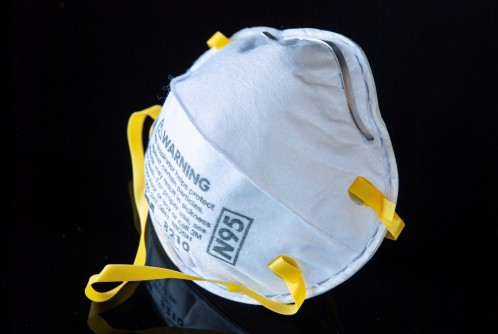Rensselaer Polytechnic Institute researchers have developed an accessible way to make N95 face masks not only effective barriers to germs, but on-contact germ killers. The antiviral, antibacterial masks can potentially be worn longer, causing less plastic waste as the masks do not need to be replaced as frequently.
Helen Zha, assistant professor of chemical and biological engineering and a member of the Center for Biotechnology and Interdisciplinary Studies at Rensselaer (CBIS), collaborated with Edmund Palermo, associate professor of materials science and engineering and a member of the Center for Materials, Devices, and Integrated systems (cMDIS) at Rensselaer, to fight infectious respiratory disease and environmental pollution with the perfect recipe to improve face masks.
“This was a multifaceted materials engineering challenge with a great, diverse team of collaborators,” Palermo said. “We think the work is a first step toward longer-lasting, self-sterilizing personal protective equipment, such as the N95 respirator. It may help reduce transmission of airborne pathogens in general.”
In research recently published in Applied ACS Materials and Interfaces, the team successfully grafted broad-spectrum antimicrobial polymers onto the polypropylene filters used in N95 face masks.
“The active filtration layers in N95 masks are very sensitive to chemical modification,” said Zha. “It can make them perform worse in terms of filtration, so they essentially no longer perform like N95s. They’re made out of polypropylene, which is difficult to chemically modify. Another challenge is that you don't want to disrupt the very fine network of fibers in these masks, which might make them more difficult to breathe through.”
Zha and Palermo, along with other researchers from Rensselaer, Michigan Technological Institute, and Massachusetts Institute of Technology, covalently attached antimicrobial quaternary ammonium polymers to the fiber surfaces of nonwoven polypropylene fabrics using ultraviolet (UV)-initiated grafting. The fabrics were donated by Hills Inc. courtesy of Rensselaer alumnus Tim Robson.
“The process that we developed uses a really simple chemistry to create this non-leaching polymer coating that can kill viruses and bacteria by essentially breaking open their outer layer,” said Zha. “It’s very straightforward and a potentially scalable method.”
The team used only UV light and acetone in their process, which are widely available, to make it easy to implement. On top of that, the process can be applied to already manufactured polypropylene filters, rather than necessitating the development of new ones.
The team did see a decrease in filtration efficiency when the process was applied directly to the filtration layer of N95 masks, but the solution is straightforward. The user could wear an unaltered N95 mask along with another polypropylene layer with the antimicrobial polymer on top. In the future, manufacturers could make a mask with the antimicrobial polymer incorporated into the top layer.
Thanks to a National Science Foundation Rapid Response Research (RAPID) grant, Zha and Palermo started their research in 2020 when N95 face masks were in short supply.
Healthcare workers were even reusing masks that were intended to be single use. Fast forward to 2022 and face masks of all types are now widely available. However, COVID rates are still high, the threat of another pandemic in the future is a distinct possibility, and single use, disposable masks are piling up in landfills.
“Hopefully, we are on the other side of the COVID pandemic,” said Zha. “But this kind of technology will be increasingly important. The threat of diseases caused by airborne microbes is not going away. It’s about time that we improved the performance and sustainability of the materials that we use to protect ourselves.”
“Attaching chemical groups that kill viruses or bacteria on contact to polypropylene is a smart strategy,” said Shekhar Garde, Dean of the School of Engineering at Rensselaer. “Given the abundance of polypropylene in daily life, perhaps this strategy is useful in many other contexts, as well.”
At Rensselaer, Zha and Palermo were joined in the research by Mirco Sorci, Tanner D. Fink, Ruiwen Chen, Katharine Dovidenko, and former Rensselaer researcher Brigitte L. Arduini. Vaishali Sharma, Sneha Singh, and Caryn L. Heldt contributed from Michigan Technological University. “Virucidal N95 Respirator Face Masks Ultrathin Surface-Grafted Quaternary Ammonium Polymer Coatings” was produced with support from the National Science Foundation.
Source: Rensselaer Polytechnic Institute (RPI)
